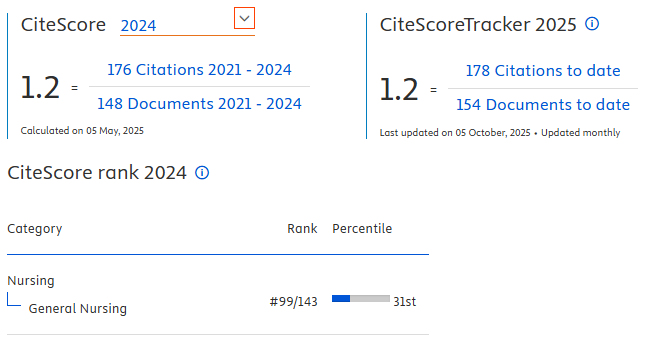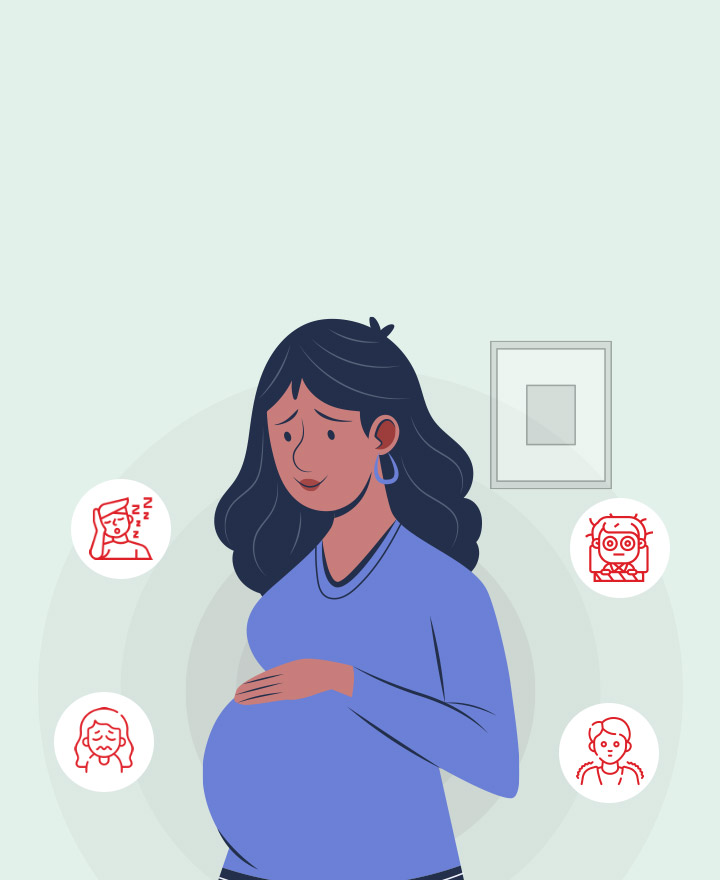Waist Circumference as a Predictor for Menstrual Cycle Disturbance Among College Student
Downloads
Introduction: Menstrual cycle disturbance is the sign of a reproductive health problem, yet the cause tends to be multifactorial. This study aimed to analyze the risk factors of menstrual cycle disturbance which related to nutrition status among college students.
Methods: This was an observational analytical study with a cross-sectional approach. There were 59 participants taken as samples according to inclusion criteria using proportionate stratified random sampling. Data were analyzed with chi-square and multiple logistic regression test.
Results: Results found that 35.6% of participants experienced menstrual cycle disturbance. Bivariate analysis showed significant correlation between body fat percentage (p= 0.038, OR: 2.417) and waist circumference (p= 0.003, OR: 2.956) with menstrual cycle disturbance, otherwise no correlation found between Body Mass Index (BMI) (p= 0.052, OR: 2.145), subcutaneous fat thickness (p= 1, OR: 1.279), and total cholesterol levels (p= 1, OR: 1.063) with menstrual cycle disturbance. Multiple logistic regression analysis showed that waist circumference became determinant factor among other variables predicting menstrual cycle disturbance in this study (p= 0.002, OR: 7.260).
Conclusion: Waist circumference and body fat percentage were both risk factors of menstrual cycle disturbance, yet waist circumference was found being a determinant predictor to predict menstrual cycle disturbance among college student. Female students may pay particular attention to their waist circumference for detection of reproductive health problem earlier, especially regarding menstruation cycle disturbance.
Arum, V. R. (2015). Hubungan Status Gizi dengan Kejadian Oligomenore pada Sisiwi di SMK PERINTIS 29 UNGARAN. Semarang: DIV Kebidanan STIKES Ngudi Waluyo Ungaran.
Benson, R. C., & Pernoll, M. L. (2008). Buku Saku Obstetri dan Ginekologi. Jakarta: EGC.
Cahyono, S. B. (2008). Gaya Hidup dan Penyakit Modern. Yogyakarta: Kanisius.
Departemen Kesehatan Republik Indonesia. (2013). Riset Kesehatan Dasar 2013. [online] Available at: www.depkes.go.id/resources/download/general/Hasil%20Riskesdas%202013.pdf. (Accessed: September 2, 2017).
Dovom, R. M., Tehrani, R. F., Djalalinia, S., Cheragi, L., Gandavani, S. B., & Azizi, f. (2016). Menstrual Cycle Irregularity and Metabolic Disorders: a Population-Based Prospective Study. Plos One, 11(12), e0168402. doi:10.1371/journal.pone.0168402.
Fritz, M. A., & Speroff, L. (2011). Clinical Gynecology Endocrinology and Infertility (8th ed.). USA: Lippincott Williams & Wilkins.
Greenstein, B., & Wood, D. F. (2010). At a Glance Sistem Endokrin (2nd ed.). Jakarta: Erlangga.
Hidayah, N., Rafliudin, M. Z., & Ronny, A. (2016). Hubungan Status Gizi, Asupan Gizi dan Aktifitas Fisik dengan Siklus Menstruasi Remaja Putri Pondok Pesantren Salafiyah Kauman Kabupaten Pemalang Tahun 2016. Jurnal Kesehatan Masyarakat, IV(4), 537-544.
Jena, P., Panda, J., Mishra, A., & Narahari, A. (2017). Menstrual Pattern and Body Mass Index in Adolescent School Girls; a cross-sectional study. Global Journal for Research and Analysis, VI(6), 29-31. doi:10.1186/s12905-016-0354-y.
Kim, M.-J., Lim, N. K., Choi, Y. M., Kim, J. J., Hwang, K. R., Chae, S. J., & Kim, T. (2014). Prevalence of metabolic syndrome is higher among non-obese PCOS women with hyperandrogenism and menstrual irregularity in Korea. Plos One, IX(6), e99252. doi.org/10.1371/journal.pone.0099252.
Lemeshow, S., & Lwanga, S. K. (1990). Adequacy of Sample Size in Health Studies. Singapore: John Wiley & Sons on behalf of World Health Organization.
Manuaba, I. G., Manuaba, C. I., & Manuaba, F. I. (2010). Pengantar Kuliah Obstetri. Jakarta: EGC.
Mustaqeem, M., Sadullah, S., Waqar, W., Farooq, M. Z., Khan, A., & Fraz, T. R. (2015). Obesity with Irregular Menstrual Cycle in Young Girls. Mymensingh Medical Journal, 24(1), 161-167.
National Health Service. (2016). NHS Choices. [online] Available at: https://www.nhs.uk/conditions/obesity.
(Accessed: April 4, 2018).
Noviandari, I. (2016). Hubungan Antara Status Gizi dan Anemia dengan Siklus Menstruasi Pada Remaja Putri di SMA BAtik 1 Surakarta. [online] Available at: http://onesearch.id/Record/IOS2728.44689.
(Accessed: September 2, 2017).
Rachmawati, P. A., & Murbawani, E. A. (2015). Hubungan Asupan Gizi, Aktivitas Fisik, Persentase Lemak Tubuh dengan Gangguan Siklus Menstruasi pada Penari.[online] Available at: http://onesearch.id/Record/IOS2852.45791?widget=1.
(Accessed: September 2, 2017).
Rakhmawati, A., & Fithra, D. F. (2013). Hubungan Obesitas dengan Kejadian Gangguan Siklus Menstruasi pada Wanita Dewasa Muda. Jurnal of Nutrion College, 2(1), 214-222.
Ranggadwipa, D. D., & Murbawani, E. A. (2014). Hubungan Aktivitas Fisik dan Asupan Energi Terhadap Massa Lemak Tubuh dan Lingkar Pinggang pada Mahasiswa Fakultas Kedokteran Universitas Diponegoro. [online] Available at: http://eprints.undip.ac.id/44523/
(Accessed: March 18, 2018).
Rasdini, I. G. (2016). Hubungan Lingkar Pinggang dengan Kadar Kolesterol LDL Pasien Penyakit Jantung Koroner di Ruang ICCU RSUP Sanglah Bali. Jurnal Kesehatan, VII(1), 46-51. [online] Available at: https://www.poltekkes-tjk.ac.id/ejurnal/index.php/JK/article/view/117/103.
(Accessed: January 2, 2018).
Rizki, N. (2015). Hubungan Status Gizi dengan Siklus Menstruasi pada Remaja Putri Kelas XI di SMK N 4 Yogyakarta.Dissertation. Yogyakarta: Sekolah Tinggi Ilmu Kesehatan 'Aisyiyah.
Santoso, B. (2014). Sindroma Ovarium Polikistik: Problem Reproduksi dan Tantangannya Terkait dengan Gaya Hidup Perempuan Indonesia. Surabaya: Universitas Airlangga.
Seif, M. W., Diamond, K., & Nickkhoo-Amiry, M. (2014). Obesity and Menstrual Disorders. Best Practice and Research Clinical Obstetrics and Gynaecology, 516-527. HYPERLINK "https://doi.org/10.1016/j.bpobgyn.2014.10.010" t "_blank" o "Persistent link using digital object identifier" doi:
1016/j.bpobgyn.2014.10.010
Song, J.-Y., Kim, M.-H., Paik, J.-S., Kim, H.-S., & Na, K.-S. (2016). Association Between Menstrual Irregularity and Dry Eye Dieses: A Population-Based study. Cornea, XXXV(2), 193-198.doi: 10.1097/ICO.0000000000000941.
Welch, C. (2011). Balance Your Hormones, Balance Your Life. Jakarta: Penebar Plus.
West, S., Lashen, H., Bloigu, A., Franks, S., Puuka, K., Ruokonen, A., . . . Papunen, L. M. (2014). Irregular Menstruation and Hyperandrogenaemia in Adolescence are Associated with Polycystic Ovary Syndrome and Infertility in Later Life: Northern Finland Birth Cohort 1986 Study. Human Reproduction, 29(10), 2339-2351.doi: 10.1093/humrep/deu200
Yani, N. G. (2016). Hubungan Aktivitas Fisik dengan Siklus Menstruasi pada Atlet Kontingen PON XIX Jawa Barat di KONI Sulawesi Selatan. [online] Available at: CORE:https://core.ac.uk/download/pdf/77626835.pdf
(Accessed: September 2, 2017).
Authors who publish with Jurnal Ners agree to the following terms:
- Authors transfer the Copyright and grant Jurnal Ners the right of first publication with the work simultaneously licensed under a Creative Commons Attribution 4.0 International License that allows others to remix, adapt and build upon the work with an acknowledgment of the work's authorship and of the initial publication in Jurnal Ners.
- Authors are permitted to copy and redistribute the journal's published version of the work (e.g., post it to an institutional repository or publish it in a book), with an acknowledgment of its initial publication in Jurnal Ners.
Jurnal Ners requires a formal written declaration and transfer of copyright from the author(s) for each article published. We, therefore, ask you to complete and return this form, retaining a copy for your own records. Your cooperation is essential and appreciated. Any delay will result in a delay in publication. The form can be downloaded HERE.
































